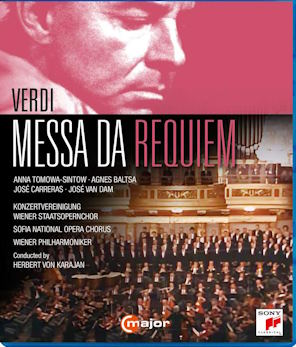
Giuseppe Verdi (1813-1901)
Messa da Requiem (1874)
Anna Tomowa-Sintov (soprano), Agnes Baltsa (mezzo-soprano), José Carreras (tenor), José van Dam (bass-baritone)
Sofia National Opera Chorus, Konzertvereinigung Wiener Statsopernchor
Wiener Philharmoniker/Herbert von Karajan
rec. live, June 1984, Grosser Saal, Musikverein, Vienna, Austria
Reviewed in surround sound.
C Major 761704 Blu-ray [93]
The first few pages of this mighty score are marked pp and sempre ppp, sotto voce and il più piano possibile. Also, the strings are muted, so Verdi did expect a hushed and reverent atmosphere. That is what we get here, and each time later when the same mood is evoked. The score, often decried as “operatic”, has had many successful recordings by conductors familiar with the opera pit, including Solti, Abbado, Giulini and Muti. Karajan had that experience too, but also conducted much religious choral music, from Bach’s B minor mass to the Requiems by Mozart and Brahms, with rather different texts, of course. Not that he is purely reverential and mutes the excitement Verdi generates at many moments. Rather, this performance seems to me to strike an ideal balance between the spiritual and the dramatic, which must surely have been how Verdi saw the text.
Karajan is intriguing to watch in this late film, made just five years before his death. He uses no baton, and his hands are expressive of more than tempo and dynamic. Unlike when he is giving a purely orchestral work, he has his eyes open for the choir and soloists. For the first occasion of a forte marking, the Te decet hymnus, Karajan notes the increase of forward motion and the hint of plainsong, keeping us in the cloister, not the opera house. The command of musical shape and of orchestra and choir balance are very satisfying in this opening Requiem and Kyrie, but this is a work Karajan conducted many times.
He also knows singers, and has cast a strong team of soloists. The then young and young-looking José Carreras is generally fine. He is sometimes too loud, or loud too soon, as on his first entry. The first forte is four bars into his Kyrie (four after figure 4 in the vocal score), but he is forte from the start. But with such fresh Italianate tone and ardour, it is easy to be as forgiving as the conductor was. In his Ingemisco and when launching the Hostias, he is closer to the score and to its spirit. His male colleague, bass-baritone José van Dam, is an example of Karajan’s frequent preference for lighter voices with attractive tone over the weightier voice Verdi (whose score asks for a bass) implies in some of the writing, and which we usually hear on disc. But Van Dam is very good. He manages the lowest notes quite well enough, and his Mors stupebit is suitably sepulchral.
Agnes Baltsa is the rich-toned mezzo, with plenty of rhetorical flair for the declamatory Liber scriptus. She sings beautifully both in solo passages and in duet with her soprano colleague; their Recordare is one of their several highlights. Anna Tomowa-Sintov is perhaps the pick of the four soloists, often celestial in high passages, and with enough weight and histrionic skill to enflame the great final Libera me.
The two choirs are large enough to cover the Musikverein’s stage from wall to wall, and make a big sound in Dies irae and Tuba mirum. Prepared by Walter Hagen-Groll, they are pretty accurate in the big double fugue of the Sanctus, aided by the tempo, a touch broader than most, set by Karajan.
The Vienna Philharmonic play as well for the conductor as ever. The brass onstage and on high, are blazing in the Tuba mirum (the bass drum seems a bit shy though). The cellos sing sweetly at the start of the Offertorio, and get the merest hint of an appreciative smile from the conductor. The filming and picture quality is excellent for the mid-1980s, once you adjust to the 4:3 frame, and the surround sound is certainly widescreen in the spectacular passages.
Karajan’s main rival might be himself. This Vienna performance has close to as good a set of soloists as the world offered in 1984, but then so was the line-up for Karajan’s earlier film from 1967 at La Scala, Milan. That performance boasts Leontyne Price, Luciano Pavarotti, Fiorenza Cossotto and Nicolai Ghiaurov, and a professional Italian chorus (Deutsche Grammophon 0734055). For those who want singers whom they might have heard live, or a more modern recording with Blu-ray images and hi-res sound, there is another live La Scala recording by conductor Daniel Barenboim, with Jonas Kaufmann, Anja Harteros, Elīna Garanča and Renée Pape (Decca 074 3808). That might be hard to find, but either film with Karajan will be much more than a stopgap.
Roy Westbrook
Help us financially by purchasing from



Details
Home video producer: Hartmut Bender
Picture format: 1080i 4:3
Sound formats: PCM Stereo, and DTS-HD MA5.1
Region code: A, B, C
Booklet note in English and German
Sung in Latin. Subtitles in German, English, French, Spanish, Korean.


















